Galapagos Species Database
The Galapagos Species Database shares the information about the species from our Natural History Collections.
Camarhynchus pallidus
Pinzón carpintero, artesano, Woodpecker Finch

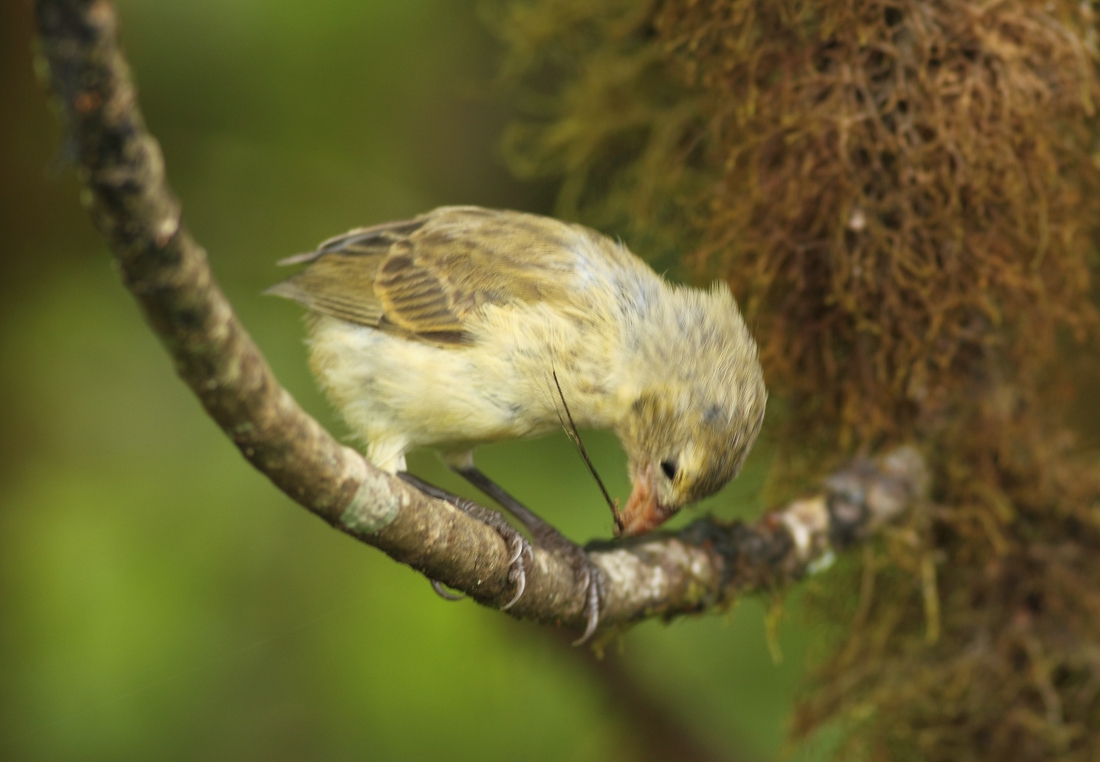
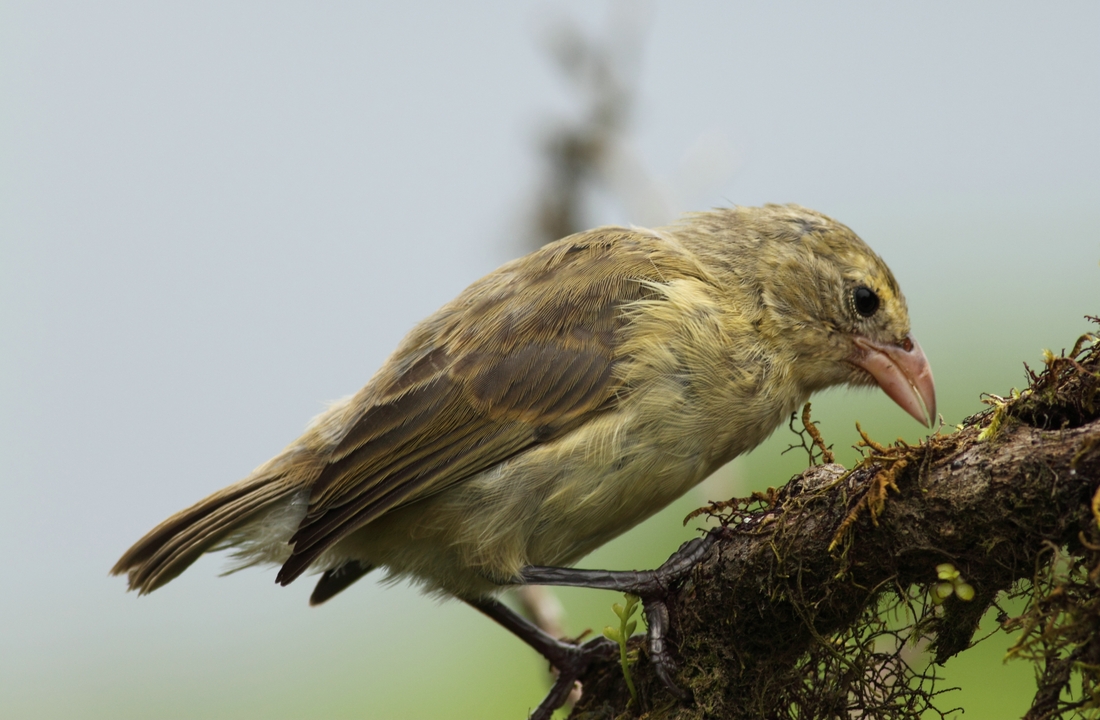
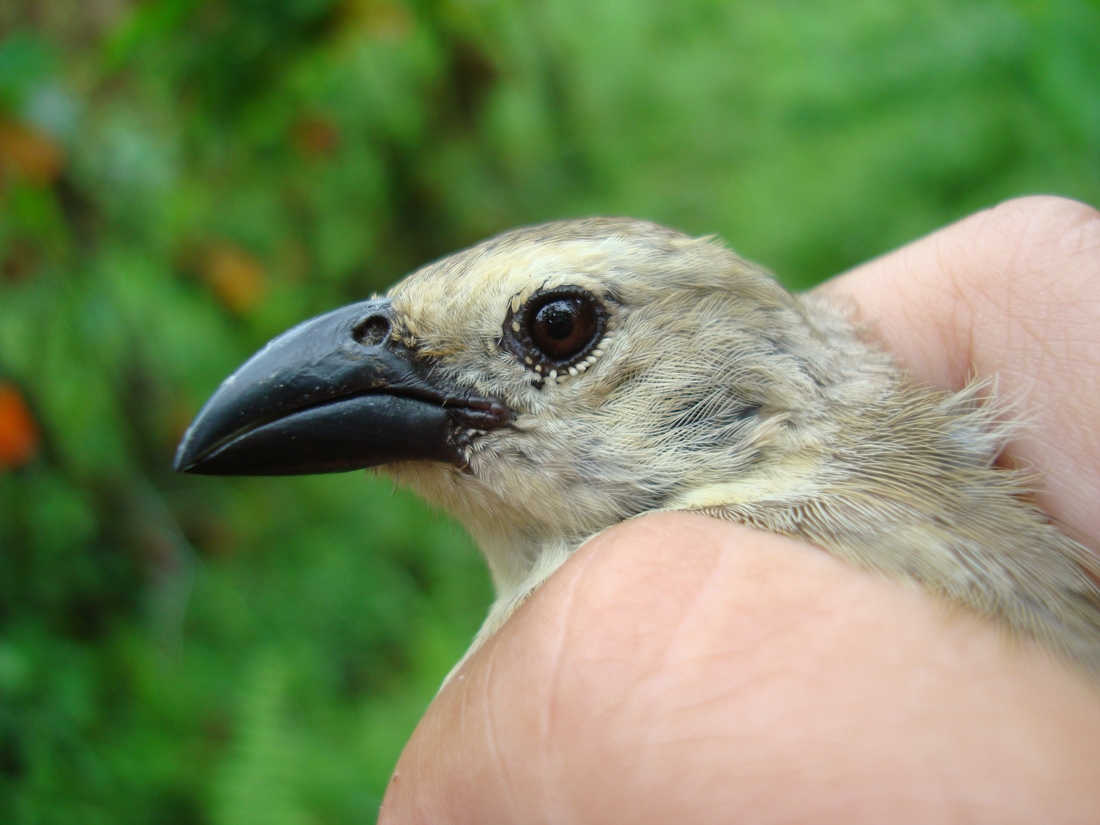
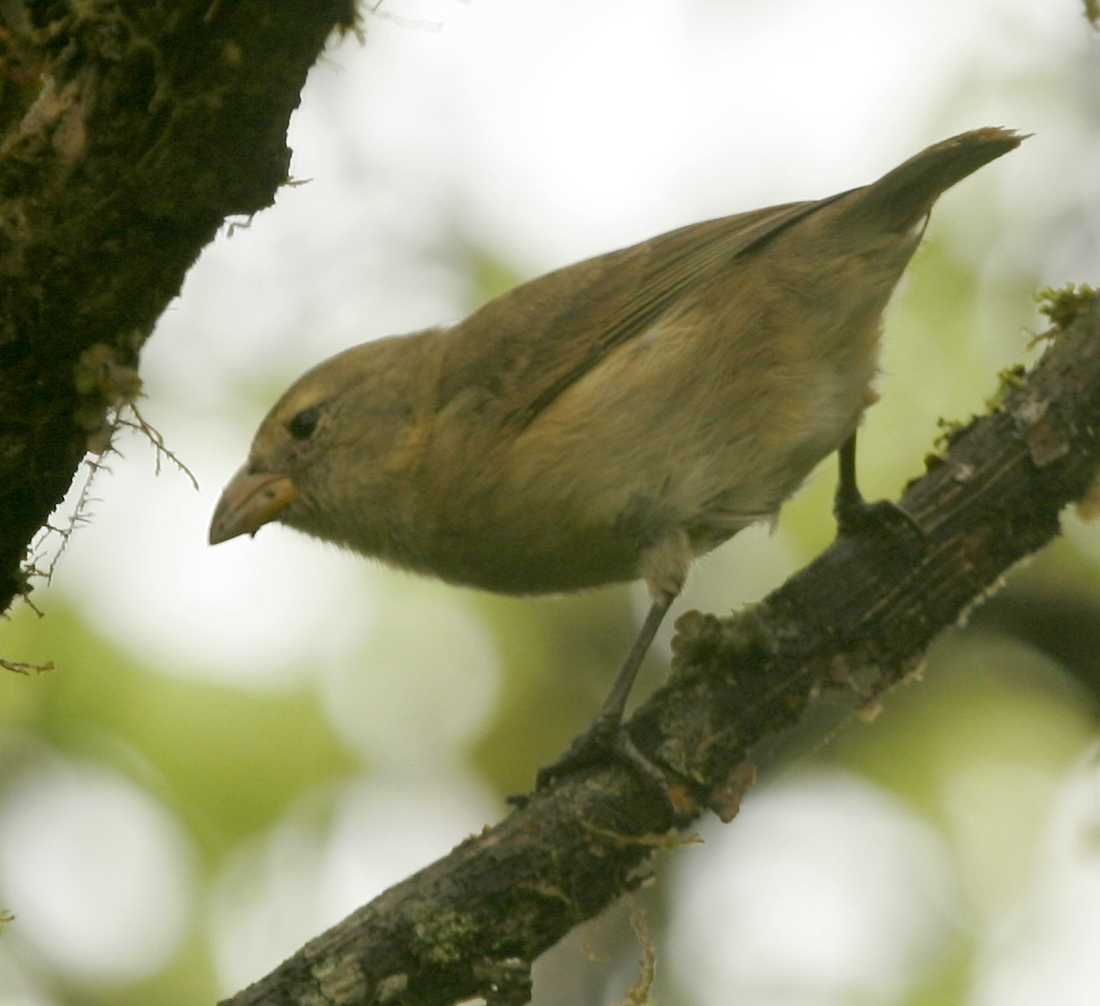
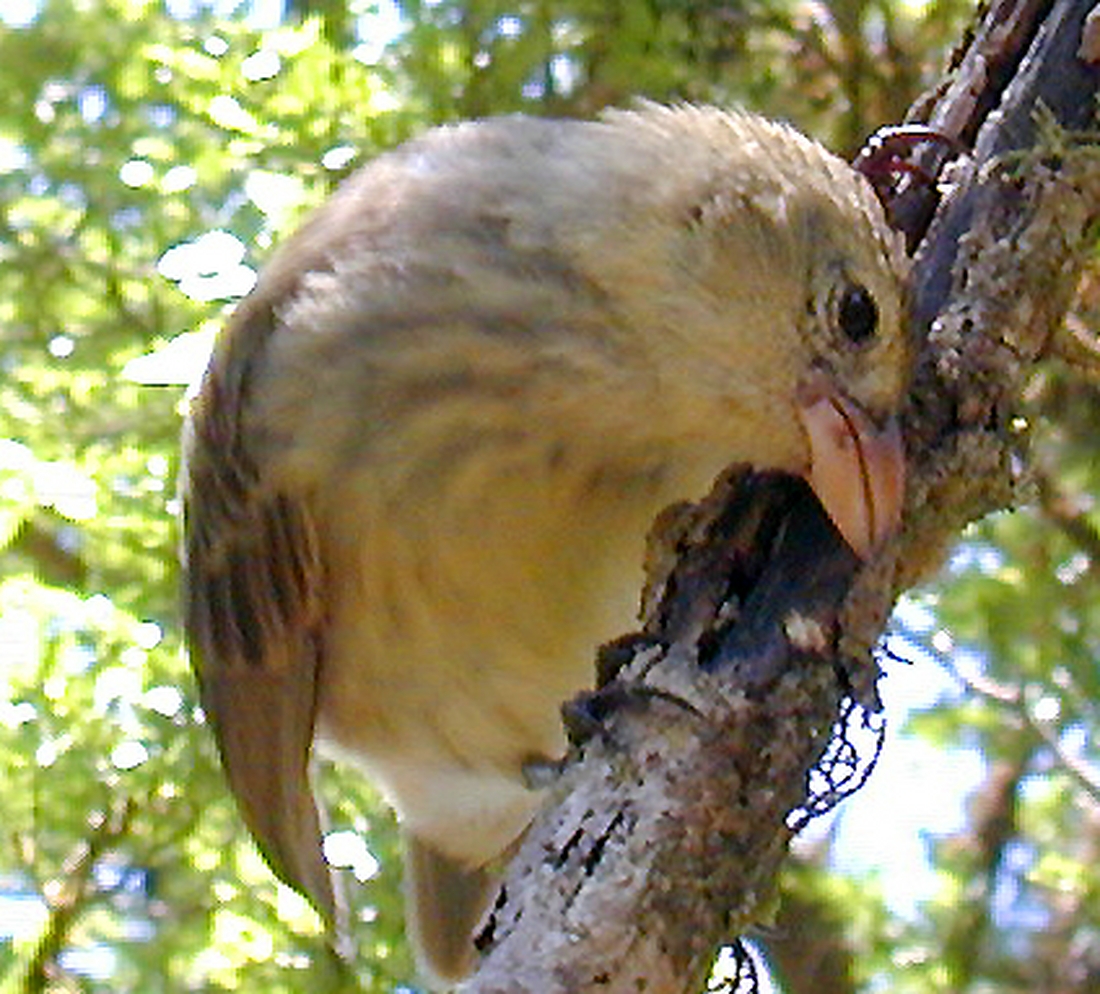

Black during reproduction, olive-light brown colour outside the breeding season and pinkish when young. Males and females look alike, with upper parts olive to warm brown with little streaking and underparts creamy to yellowish with slight streaking on upper breast. Males in San Cristóbal can get a black hood – blackish plumage was observed in approximately a fifth of the San Cristóbal population.
Threats Like other finches, current threats are mainly from diseases and parasites. Is known to be affected by the parasitic fly Philornis downsi that causes heavy chick mortality. Highland birds that contracted pox in captivity, were heavily affected by this disease.
Domain
Eukaryota
Kingdom
Animalia
Phylum
Chordata
Class
Aves
Order
Passeriformes
Family
Thraupidae
Genus
Camarhynchus
Species
pallidus
Taxon category: Accepted
Syn.: Cactornis pallida Sclater & Salvin, 1870; Cactospiza pallida; Camarhynchus pallidus pallidus (Sclater & Salvin, 1870); Camarhynchus pallidus productus Ridgway, 1894; Camarhynchus pallidus striatipecta (Swarth, 1931)
Taxon origin: Endemic
Preference for an altitude zone in Galapagos: Coastal zone - high altitude dry zone
Habitat preferences: Most common in highlands but found all the way down to the coast in forested areas.
Feeding preferences: Feeds on insects and larvae gathered from the moss on trees as well as from under the bark on branches and trunks. Quite flexible in habits, can change foraging techniques between the wet and dry season, searching more in moss in the dry season.
Trophic role: Carnivorous
Reproduction mode: Exclusively sexual
Reproductive biology: Breeds during the rainy season (December to April), possibly start breeding a few weeks earlier than other finches. Male displays in front of a dome shape nest. Once chosen, the pair either use this nest or build a new one. Only females incubate (one to three eggs), both feed the chicks. Fledglings stay for up to 6 weeks with a parent, either with the male while the female starts a new clutch, or, one with the female and the other with the male.
Distribution: Breeds on Isabela, Fernandina (probably), Santa Cruz, Santiago, San Cristóbal, and Pinzón (rarely). It has also been recorded on Rábida (specimens 1897 and 1905), Floreana (specimen 1905) and Santa Fe (two sight records 1968), and a sight record on Pinta in 1968.
- Wiedenfeld, D.A. (2006) Aves, the Galapagos Islands, Ecuador. Check List 2006 2(2): 1-27.
- Jiménez-Uzcátegui, G. Milstead, B., Márquez, C., Zabala, J., Buitrón, P., Llerena, A., et al. (2007) Galapagos vertebrates: endangered status and conservation actions. Galapagos Report 2006–2007. Charles Darwin Foundation, Puerto Ayora, p. 104–110.
- Harris, M.P. (1973) The Galápagos avifauna. Condor 75(3): 265-278.
- Salvin, O. (1876) On the avifauna of the Galápagos Archipelago. Transactions of the Zoological Society of London 9: 447-510.
- Fessl, B. Tebbich, S. (2002) Philornis downsi - a recently discovered parasite on the Galápagos archipelago - a threat to Darwin's finches? Ibis 144: 445-451.
- Swarth, H.S. (1931) The Avifauna of the Galapagos Islands. Occ. Pap. Calif. Acad. Sci. 18: 1-299.
- Dudaniec, R.Y. Fessl, B. & Kleindorfer, S. (2007) Interannual and interspecific variation in intensity of the parasitic fly, Philornis downsi, in Darwin’s finches. Biological Conservation 30: 325-323.
- Fessl, B. Couri, M.S. & Tebbich, S. (2001) Philornis downsi Dodge & Aitken, new to the Galapagos Islands (Diptera, Muscidae). Studia Dipterologic 8: 317-322.
- Kleindorfer, S. Dudaniec, R.Y. (2006) Increasing prevalence of avian poxvirus in Darwin’s finches and its effect on male pairing success. Journal of Avian Biology 37: 69-76.
- Jiménez-Uzcátegui, G. Betancourt, F. (2008) Avifauna vs automotores. Informe Galápagos 2007-2008. FCD, PNG & INGALA. Puerto Ayora, Ecuador. p. 111–114.
- Bisconti, M. Landini, W., Bianucci, G., Cantalamessa, G., Carnevale, G. Ragaini, L. & Valleri, G. (2001) Biogeographic relationships of the Galapagos terrestrial biota: parsimony analyses of endemicity based on reptiles, land birds and Scalesia land plants. J. Biogeogr. 28: 495-510.
- Donohue, K. (2011) Darwin's Finches: Readings in the Evolution of a Scientific Paradigm University of Chicago Press, Chicago, 492 pp.
- Guerrero, A. Tye, A. (2009) Darwin's Finches as seed predators and dispersers. The Wilson Journal Of Ornithology 121 (4):752-764, 2009
- Dvorak, M. Fessl, B., Nemeth, E., Kleindorfer, S.M., & Tebbich, S. (2012) Distribution and abundance of Darwin ́s Finches and other land birds on Santa Cruz Island Galapagos: evidence for declining populations. Oryx 46:78-86
- Eibl-Eibesfeldt, I. (1961) Über den Werkzeuggebrauch des Spechtfinken Camarhynchus pallidus (Slater und Slavin). Zeitschrift fur Tierpsychologie 18:342-346
- Greenhood, W. Norton, R. (1999) Novel feeding technique of the Woodpecker Finch. Journal of Field Ornithology 70:104-106.
- Stern, D. Grant, P. (1996) A phylogenetic reanalysis of allozyme variation among populations of Galápagos finches. Zoological Journal of the Linnean Society 118:119-134.
- Tebbich, S. Bshary, R. (2004) Cognitive abilities related to tool use in the woodpecker finch, Cactospiza pallida. Animal Behaviour 67:689-697.
- Tebbich, S. Taborsky, M., Fessl, B. & Blomqvist, D. (2001) Do woodpecker finches acquire tool-use by social learning? Proceedings of the Royal Society of London Series B-Biological Sciences 268:2189-2193.
- Tebbich, S. Taborsky, M., Fessl, B. & Dvorak, M. (2002) The ecology of tool-use in the woodpecker finch (Cactospiza pallida). Ecology Letters 5:656-664.
- Tebbich, S. Taborsky, M., Fessl, B., Dvorak, M. & Winkler, H. (2004) Feeding behavior of four arboreal Darwin's finches: adaptations to spatial and seasonal variability. The Condor 106:95-105
- Tebbich, S. Teschke, I. (2014) Coping with Uncertainty: Woodpecker Finches (Cactospiza pallida) from an Unpredictable Habitat Are More Flexible than Birds from a Stable Habitat. PLOS One 9:e91718
- Farrington, H. Lawson, L., Clark, C. & Petren, K. (2014) The evolutionary history of Darwin's finches: speciation, gene flow, and introgression in a fragmented landscape. Evolution doi 10.1111/evo.12484.
- IUCN (2015) The IUCN Red List of Threatened Species. Version 2015-4. <www.iucnredlist.org>. Downloaded on 20 November 2015.
- Lamichhaney, S. Berglund, J., Sällman Almén, M., Maqbool, K., Grabherr, M., Martinez-Barrio, A., Promerova, M., Rubin, C.J., Wang, C., Zamani, N., Grant, B.R., Grant, P.R., Webster, M.T., Andersson, L. (2015) Evolution of Darwin’s finches and their beaks revealed by genome sequencing Nature 518: 371-386. doi:10.1038/nature14181
- Remsen, J.V. Areta, J.I.Jr., Cadena, C.D., Claramunt, S., Jaramillo, A., Pacheco, J.F., Pérez-Emán, J., Robbins, M.B., Stiles, F.G., Stotz, D.F., Zimmer, K. J. (2016) A Classification of the Bird Species of South America. South American Classification Committee. American Ornithologists' Union http://www.museum.lsu.edu/~Remsen/SACCBaseline.htm
- IUCN (2017) The IUCN Red List of Threatened Species Version 2016-3. <www.iucnredlist.org>. Downloaded on 03 February 2017.
- Freile, J.F. Santander, T., Jiménez-Uzcátegui, G., Carrasco, L., Cisneros-Heredia, D., Guevara, E., Sánchez-Nivicela, M., Tinoco, B. (2019) Lista Roja de las aves del Ecuador Quito, Ecuador. 97 pp.
- GBIF Secretariat (2021) GBIF Backbone Taxonomy. Https://doi.org/10.15468/39omei Accessed via https://www.gbif.org/species/5284517



Feeding type: Insectivorous
This is the famous tool-using finch of Galápagos able to use a cactus spine or a twig to get larvae from holes in wood. Uses this technique mainly during the dry season in the dry zone. Young birds can learn this behaviour, but adults cannot.